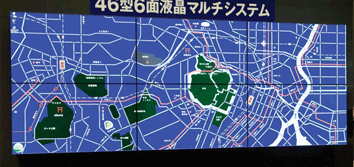Mitsubishi Debuts A Flat Option Dedicated To Control Rooms
LCD panels are making their way into more places every day, like gyms, churches, schools, and other venues. But when your clients’ city traffic management, emergency operation, and security monitoring center control rooms don’t require 24/7 operation, nor have the budget or real estate for a full-size data wall, what options are available?
Each LCD panel in a SeventySeries: FLAT Display Wall will be independent and completely accessible from the front using an optional wall mount. The entire configuration can be flush against a wall, saving precious real estate.
Some integrators and their customers consider using stacked televisions because the price is right and endusers are familiar with the brands they see in retail outlets. Unfortunately, you’ll quickly realize that TVs are impractical for a control room because they’re not designed for consistent and extended usage, the bezels are too large, they can’t manage the multiple input sources required for computer windowing, networking, etc. And worst of all, when the going gets tough, the TVs might just stop working.
Digital signage LCD panels have also become more popular in control rooms, but they too have limitations in these environments. Customers need seamlessness in their control room, so using any monitor designed as a single-panel display is inappropriate. These monitors have poor brightness uniformity, typically a 50 percent difference from the center to the corners. In a single display it’s not noticeable, but when you tile them together, the dark areas become obvious at the seams while the center of the displays show as hotspots, which can be distracting and disorienting.
These monitors also have input and bezel size limitations. Although most signage displays have a wide variety of inputs, they are fixed and there is no way a customer can choose which input types fit their application best. And some monitors have thinner bezels, but they can up to an inch and a half thick on each side, leading to a wide three-inch gap between screens. In most control rooms, any gap wider than a few millimeters is simply too large to create an effective display wall.
The most effective solution for your not-so-continuously-used control room clients is to install LCD panels that are designed and built only for control room environments. Or as the saying goes, “Use the right tool for the right job.”
Mitsubishi recently channeled its display wall technology and expertise into creating a new super-thin-bezel LCD display called SeventySeries: FLAT. Unlike similar LCD displays designed for retail signage, these new panels feature the hardware, firmware, and software necessary to reproduce consistent, high-quality images required in a control room environment.
With its built-in hardware, the flat panel displays in a SeventySeries: FLAT data wall functions as a command center hub by incorporating built-in windowing of up to six sources per display such as computers, security/traffic cameras, television receivers and the like. Each of these panels offers three input card slots, allowing users to pick and choose the inputs necessary to satisfy their needs. Different cards offer inputs like DVI, VGA, component/Svideo/ composite video, and others.
Additionally, daisy-chain input cards can be used to display different input source windows on any monitor within the display wall, allowing them to move freely over the entire wall.
Because each LCD panel has its own color and brightness signature, it’s important to balance and unify each to achieve consistency across the wall. SeventySeries: FLAT panels also have a digital Color Space Control function that blends and adjusts colors automatically, while its Digital Gradation Circuit distributes brightness uniformly across the screen. These two technologies work together to ensure a brightly lit, richly colored image reproduction that looks even and consistent from edge to edge, across multi-screen Seventy- Series: FLAT wall configurations.
With its minute 7.3mm mullion (screen to screen gap), alignment of screens becomes critical, so Mitsubishi developed a unique three-axis motorized mount for precise pixel-to-pixel adjustment. Critical information remains clear across the screen so gaps, text and images line up seamlessly.
So install a television in your living room, put retail signage displays in the mall, and when your control room clients need a lite-version data wall, consider the SeventySeries: FLAT, a super-thin bezel LCD display designed only for control rooms.
